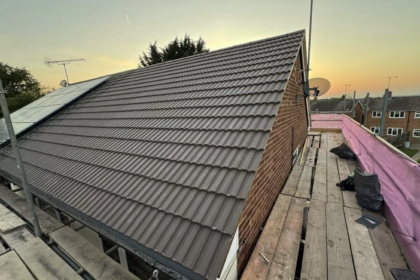 How to Prevent Blocked Gutters and Roof Leaks This Autumn
How to Prevent Blocked Gutters and Roof Leaks This Autumn
We’ve had a hot, dry summer, but that’s coming to an end. Rain, cooler temperatures and the hint of leaves turning colour all show that autumn’s coming — and that poses risks to your roof.
If cracks have developed in your roof, you could find water leaking inside your home, doing serious damage. At the same time, blocked gutters can cause spills that could threaten the building’s structure. So how can you prevent blocked gutters and roof leaks this autumn?
Why Check Your Roof in Autumn?
Autumn typically brings in wilder weather — heavy rain, strong winds and storms, some of which will be bad enough to have names. This can crack tiles or completely dislodge them, tear the felt, and damage the flashing around chimney stacks or other structures.
If this damage isn’t repaired, it can result in water seeping through into the roofspace and even down into the house. Damp can cause timbers to rot, potentially leading to structural damage, or result in the growth of mould or mildew. Besides looking unsightly, the spores from this can pose severe health hazards.
How to Check Your Roof in Autumn
The simplest way to check your roof for damage is through binoculars from ground level. You should be able to make out whether there’s damage, but if you’re able to inspect from the top of a ladder, you’ll get a better view. This will also let you check whether valleys or flat roof sections have moss or debris on them, which can encourage water to pool.
An alternative way to check for holes in the roof is to go into the roof space during the day with no artificial lighting. If you see any pricks of light, that’s evidence of damage.
Why Check Your Gutters in Autumn?
One of the most dangerous things for your roof is water pooling and working cracks open. While this can be caused by growths such as moss, the most likely reason is that the gutters and downpipes are blocked. This can very easily happen in the autumn, with dead leaves, twigs and other debris blown around in the wind.
If your guttering is either blocked or cracked, the water will either pool, causing damage to the roof, or else spill over the edges of the roof. This means that, instead of going safely into the drain, it will run down the walls and may get into the foundations, causing serious damage.
How to Check Your Gutters in Autumn
It may be obvious that your guttering is seriously damaged, from water pouring down the walls or gathering on the ground. Otherwise, inspection needs to be close up. If you’re going up a ladder to look at your roof, you can examine the gutters at the same time.
Needless to say, you should only use a ladder to inspect your roof if you’re an experienced DIYer and used to working at height, not to mention having all the appropriate safety equipment. If not, this job should be left to the experts.
Get a Professional Roofer In
If you really know what you’re doing, you may be able to make the close-up inspections yourself, and even clean out the gutters. However, this isn’t something for most people to try, and repairs to the roof itself should never be undertaken as a DIY project.
In any case, it’s better to get professional roofers to inspect your roof. They’ll be able to see issues you might miss, as well as carry out the repairs promptly. Get in touch with Empire to find out more about how we can protect your roof against the damage autumn brings.









